Overview
The Center of Excellence (CoE) program aims to elevate performance and stimulate innovation. By centralizing expertise, standardizing processes, and aligning strategic goals with functional capabilities, CoEs play a crucial role in organizational success.
This program facilitates knowledge sharing and enhances operational efficiency through technologies such as Robotic Process Automation (RPA). Furthermore, it fosters a culture of continuous improvement.
Ultimately, these elements drive success in a competitive landscape. As organizations strive for excellence, the CoE program stands as a vital component in achieving strategic objectives and operational effectiveness.
Introduction
In an increasingly complex and competitive business landscape, Centers of Excellence (CoEs) have emerged as a pivotal force in driving operational efficiency and fostering innovation. These specialized teams centralize expertise and cultivate best practices, enhancing overall performance across organizations. As they navigate the challenges of 2025, CoEs are proving indispensable by aligning strategic objectives with operational capabilities, empowering organizations to adapt swiftly to market dynamics.
By leveraging advanced technologies such as Robotic Process Automation (RPA) and artificial intelligence, CoEs are reshaping workflows and enhancing decision-making processes. This positions them as leaders in their respective fields. This article delves into the transformative impact of CoEs, exploring their core objectives, the challenges they address, and the unique value they bring to organizations striving for continuous improvement and sustained growth.
Understanding the Center of Excellence (CoE) Concept
A Center of Excellence (CoE) operates as a dedicated team or entity within a company, focusing on a specific area of expertise. Its core mission is to provide leadership, establish best practices, conduct research, and offer support and training. This raises an essential question: what is the objective of the CoE program in elevating performance and stimulating innovation? By centralizing knowledge and resources, centers of excellence enable organizations to leverage their expertise effectively, resulting in enhanced processes, cost savings, and a culture of continuous improvement.
In 2025, the objective of the CoE program is underscored by the significance of centers of excellence in aligning strategic goals with functional capabilities. This alignment is vital for enhancing efficiency and effectiveness across various functions. For instance, the experience of the Willis-Knighton Health System illustrates the challenges healthcare providers face in establishing centers of excellence, often resorting to a trial-and-error approach due to limited guidance.
Their insights highlight the necessity of a comprehensive understanding of the delivery model and its benefits to achieve high-quality care. This understanding ultimately serves as a blueprint for other healthcare establishments aiming to replicate successful processes. The lessons learned from their experience emphasize the objective of the CoE program, reinforcing the importance of investing in a detailed comprehension of CoE operations.
Current statistics reveal that establishing CoEs requires substantial financial resources for successful operations; however, this investment is justified by the excellence they foster. Leaders must continuously monitor and adjust their strategies to ensure alignment with the organization’s purpose and practical realities, prompting the question: what is the objective of the CoE program in driving success? This dynamic nature of operational excellence is essential for organizations to thrive in a competitive landscape.
Expert opinions indicate that CoEs can significantly enhance the depth and breadth of services available within communities. As JLF Jr. states, “Centers of excellence have the ability to dramatically enhance the depth and breadth of healthcare services available in communities,” showcasing their potential to transform operational efficiency. By implementing a CoE, organizations streamline workflows through Robotic Process Automation (RPA) and Business Intelligence (BI), while also fostering an environment conducive to innovation and growth, making them indispensable in today’s competitive landscape.
Furthermore, the findings and lessons learned from these initiatives will be widely disseminated, highlighting the importance of sharing knowledge and best practices in establishing Centers of Excellence.

Core Objectives of the CoE Program
When considering the core objectives of a Center of Excellence (CoE) program, one might ask: What is the objective of the CoE program in driving operational efficiency, fostering innovation, and enhancing collaboration across various departments? By standardizing processes and practices, centers of excellence enable entities to streamline workflows, minimize redundancies, and significantly boost overall productivity. A study by McKinsey & Company found that educational institutions implementing data-driven decision-making through CoEs experienced a remarkable 15% increase in overall performance.
Moreover, CoEs serve as incubators for new ideas and technologies, enabling entities to remain competitive in rapidly evolving markets. They play a crucial role in facilitating knowledge sharing and collaboration among teams, ensuring that best practices are effectively disseminated throughout the entity. This collaborative setting not only boosts efficiency but also aligns strategic goals, ultimately resulting in enhanced performance.
Furthermore, entities with a CoE are more inclined to establish robust data governance frameworks. The Data Governance Institute reported that 80% of such entities have implemented effective governance strategies. This highlights the significance of Centers of Excellence in driving innovation and standardization, prompting us to consider: What is the objective of the CoE program for entities aiming to thrive in today’s data-rich environment?
A notable example is Harvard University, which improved faculty and student engagement and enhanced administrative efficiency by integrating a comprehensive learning management system. This demonstrates the tangible benefits of Center of Excellence initiatives in fostering collaboration and efficiency improvements.
Additionally, utilizing Robotic Process Automation (RPA) solutions like EMMA RPA and Microsoft Power Automate can significantly boost productivity and employee morale by automating manual workflows. These innovative tools streamline processes, reduce errors, and provide a risk-free ROI assessment, making them invaluable in the pursuit of excellence. A case study on a mid-sized company illustrates this: GUI automation led to a 70% reduction in data entry errors and an 80% improvement in workflow efficiency, showcasing the transformative impact of RPA in enhancing business productivity and decision-making capabilities.
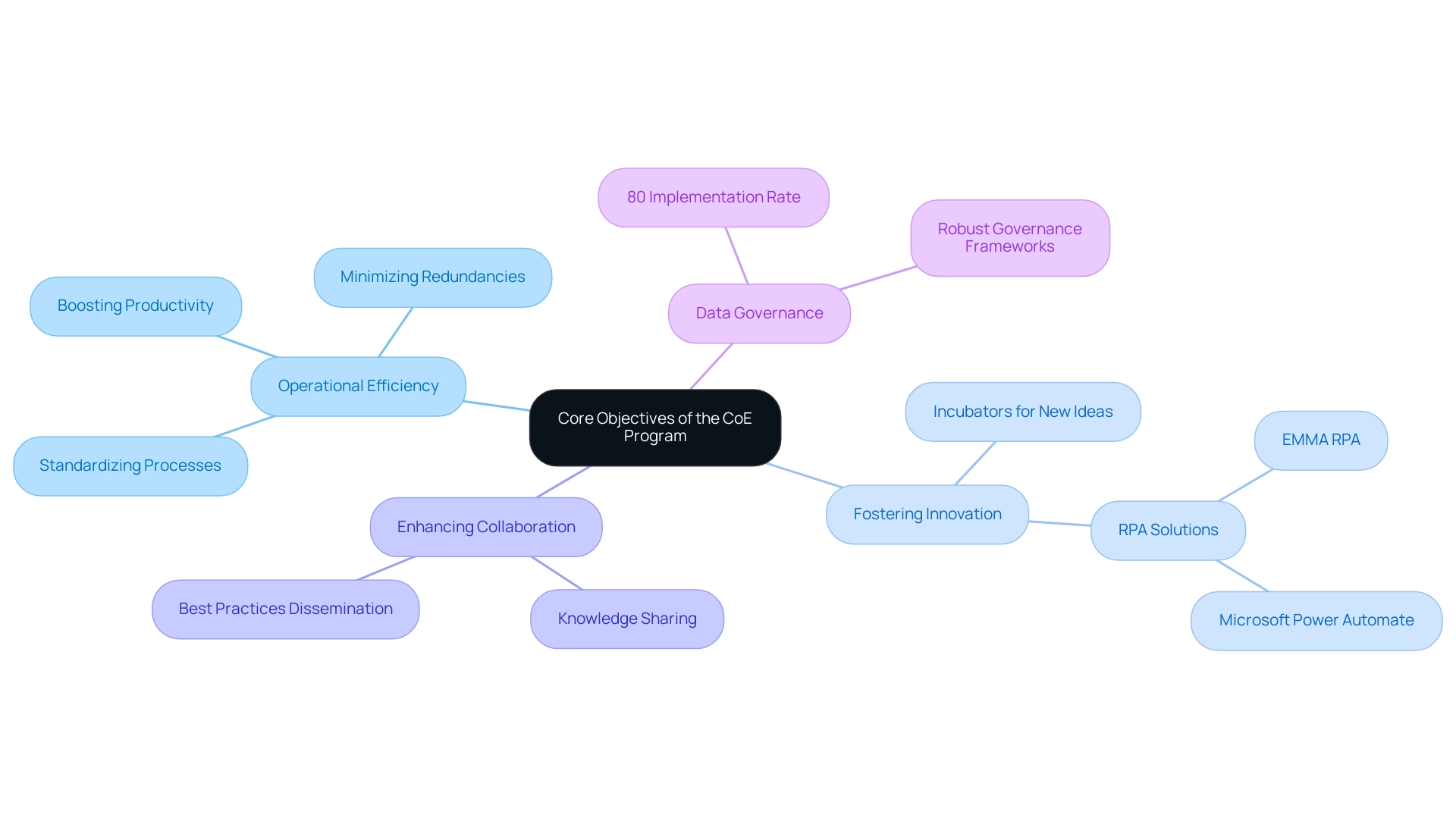
Addressing Operational Challenges through CoEs
Centers of Excellence are pivotal in addressing the operational challenges that companies face today, underscoring the objective of the COE program. By centralizing expertise and resources, these centers effectively clarify the program’s goals by identifying inefficiencies and implementing standardized processes that significantly enhance productivity. Unfortunately, many organizations still depend on cumbersome reporting tools or manual spreadsheets due to limited analytics capabilities in their business software, which restricts their ability to make informed decisions.
In response, organizations can implement robotic process automation (RPA) solutions, such as EMMA RPA and Microsoft Power Automate, to streamline workflows. These tools not only minimize errors but also free employees to focus on more strategic, value-adding activities, thereby boosting overall employee morale. The impact of RPA on productivity is substantial. As companies prepare for uncertainties in 2025, RPA adoption is expected to become a cornerstone of strategic planning.
Organizations that embrace RPA can anticipate enhanced efficiency and a reduction in operational challenges, enabling them to remain agile in the face of unexpected market changes. A notable case study illustrating this is the Always-On Strategy for Business Resilience, which highlights the importance of adaptability and informed decision-making in a rapidly changing environment. This strategy closely aligns with RPA implementation, equipping businesses to respond swiftly to market dynamics.
Moreover, Centers of Excellence are instrumental in facilitating change management, prompting us to consider the objective of the COE program. They provide essential training and support to employees, aiding them in navigating new processes and technologies. This support is critical in overcoming resistance to change, ensuring a smooth and effective transition to automated systems.
As companies increasingly recognize the significance of RPA, expert insights clarify the objective of the COE program in effectively directing this change. For instance, a case study on a mid-sized company demonstrated that by implementing GUI automation, they reduced data entry errors by 70%, accelerated testing processes by 50%, and improved workflow efficiency by 80%. This underscores the positive impact of RPA on efficiency and employee satisfaction.
The effective execution of RPA within Centers of Excellence not only addresses pressing challenges but also positions organizations for sustained growth and innovation.
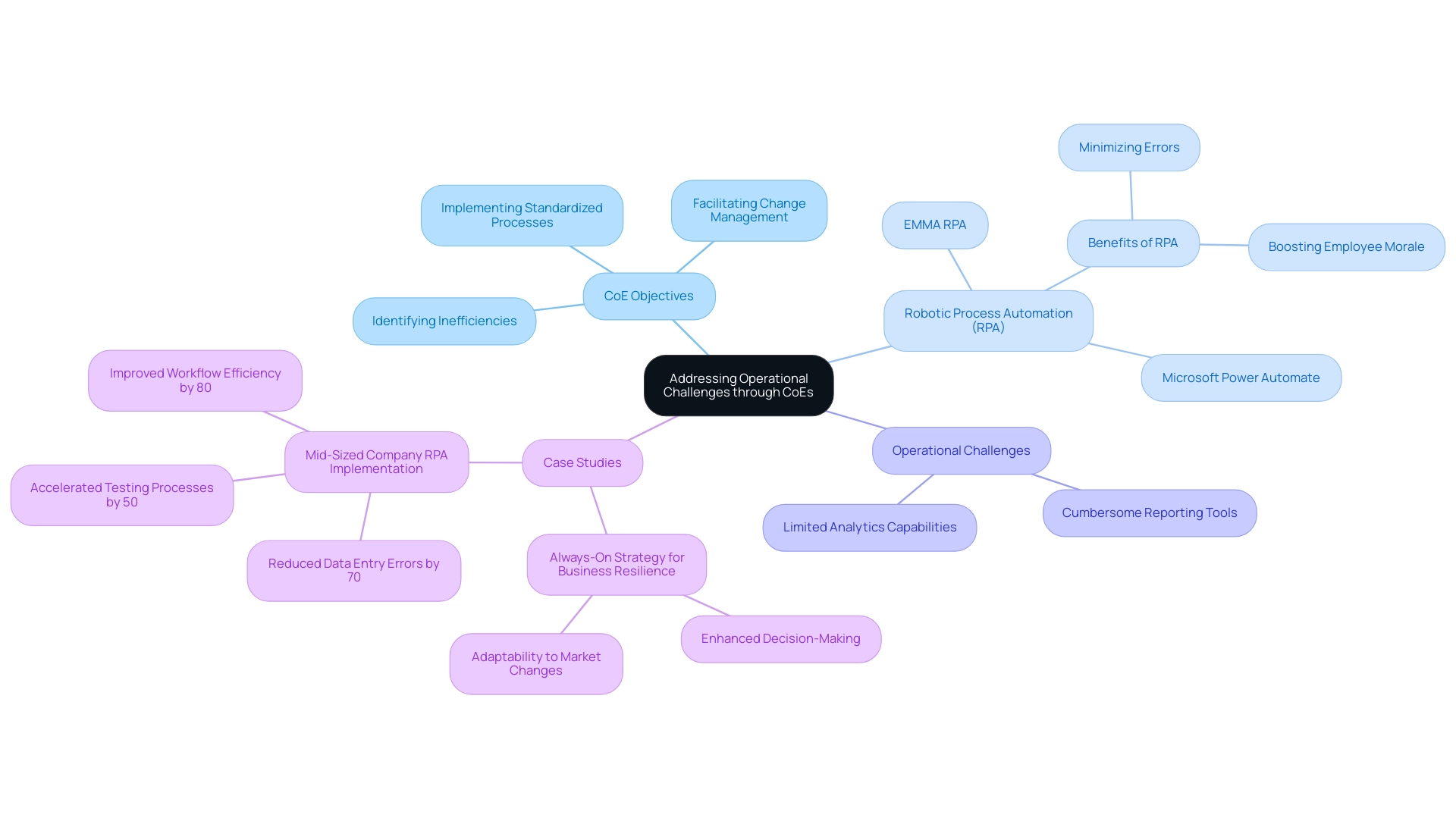
Fostering Collaboration and Change Management in CoE Initiatives
Fostering collaboration and effective change management is essential for determining the objective of the CoE program and ensuring the success of its initiatives. To effectively address employee resistance, Codes should adopt strategies that prioritize open communication and active engagement. This can be achieved through regular meetings, workshops, and feedback sessions, creating opportunities for employees to express their concerns and contribute to the development of new processes.
Moreover, providing comprehensive training and resources is crucial in helping employees adapt to changes, significantly enhancing their willingness to embrace new practices.
A study indicates that only 27% of employees feel their leadership is adequately trained in change management, highlighting a critical area for improvement. By investing in leadership development and communication strategies, companies can better align their teams with change initiatives, ensuring that leaders are equipped to guide their teams effectively.
Incorporating technologies such as Robotic Process Automation (RPA) can further enhance operational efficiency by automating manual workflows, allowing teams to focus on more strategic tasks. The rapidly evolving AI landscape presents opportunities for tailored AI solutions that can address specific business challenges, ultimately driving productivity and informed decision-making. Additionally, leveraging Business Intelligence can transform raw data into actionable insights, enabling entities to make data-driven decisions that support their growth objectives.
Creating a culture of collaboration and support not only facilitates the successful implementation of initiatives but also ensures their sustainability over time. For instance, a case study on leading organizational change emphasizes the importance of effective communication and alignment between team and business goals, suggesting that tailored solutions in organizational development can lead to meaningful impacts. This corresponds with the need for centers of excellence to implement strategies designed to address their unique challenges, which raises the question of the objective of the CoE program.
In 2025, as organizations navigate the complexities of change management within center of excellence programs, understanding the objective of the CoE program is vital for leveraging data on communication effectiveness and employee engagement strategies. Statistics reveal that with open-source communication, 54% of the workforce feels informed about changes, underscoring the need for transparent and inclusive practices. Furthermore, understanding the six key areas of statistics on change initiatives—such as success and failure rates, leadership involvement, employee experience, communication strategies, workforce adaptability, and organizational relevance—can provide valuable insights into the challenges faced in change management.
By fostering collaboration and prioritizing effective change management, centers of excellence can drive innovation and operational efficiency, raising the question of the objective of the CoE program.
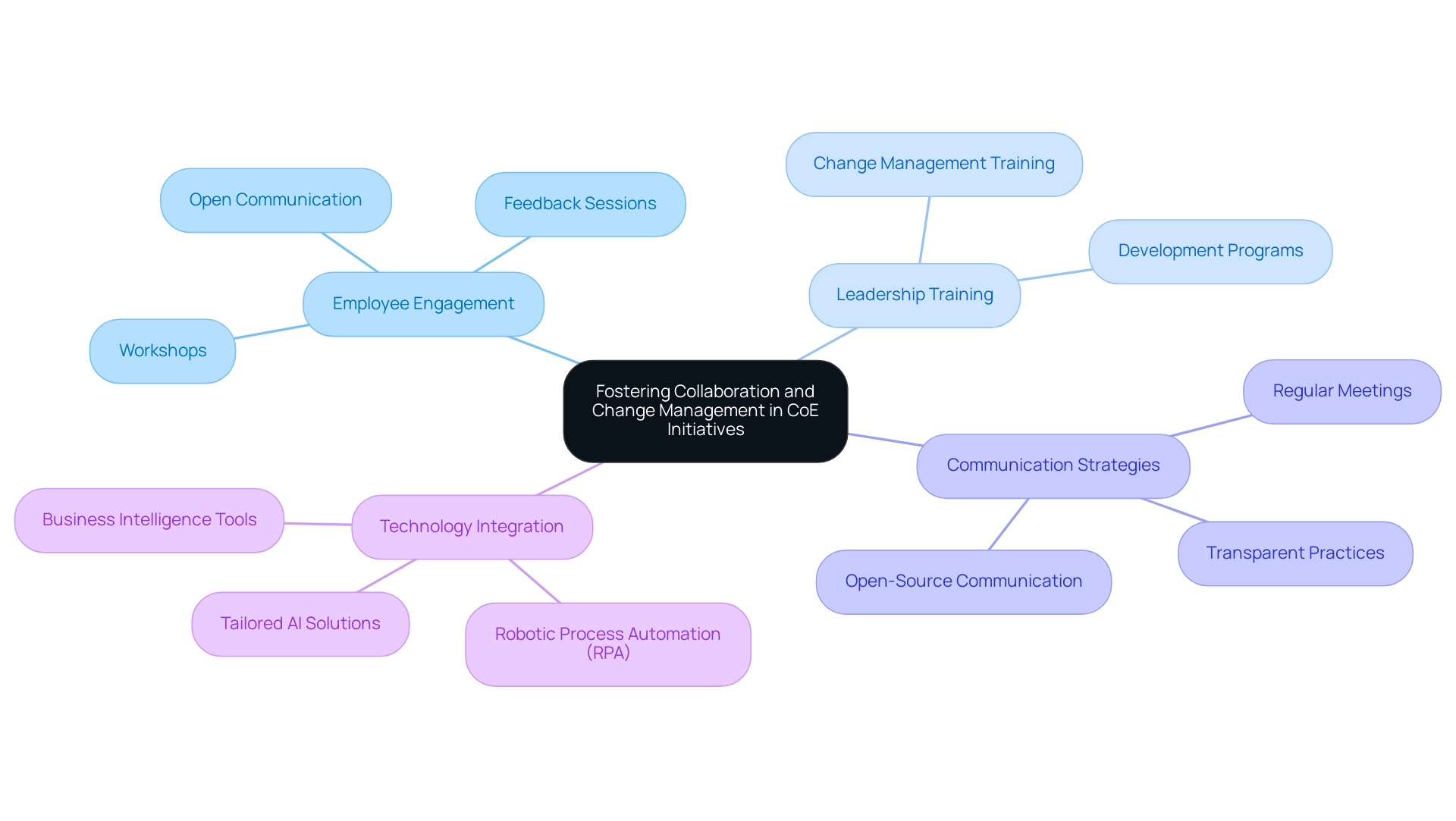
Leveraging Technology: RPA and AI in CoE Programs
Technology is integral to the success of Center of Excellence (CoE) programs, particularly through the strategic integration of robotic process automation (RPA) and artificial intelligence (AI). By implementing RPA solutions such as EMMA RPA and Microsoft Power Automate, centers of excellence can automate repetitive tasks, leading to substantial gains in efficiency and employee morale. This automation not only minimizes the risk of human error but also liberates valuable resources, enabling teams to concentrate on higher-value activities.
AI complements RPA by enhancing decision-making processes through data-driven insights. For instance, a CoE focused on data analytics can leverage AI algorithms, including tailored Small Language Models, to analyze extensive datasets, identifying trends and patterns that inform critical business strategies. This capability is increasingly vital; forecasts indicate that by 2030, RPA augmented with AI will become a standard tool in large enterprises, emphasizing the necessity for CoEs to adapt and integrate these technologies into their frameworks.
The finance and banking sectors exemplify the successful adoption of RPA, with 65% of finance firms planning to increase their automation investments. These organizations report significant time savings, improved productivity, and cost reductions, demonstrating the effectiveness of RPA in refining workflow processes. A recent case study highlighted how a leading bank implemented RPA to streamline transaction processing, resulting in a 30% reduction in processing time and a notable decrease in operational costs.
As CoEs embrace these technologies, they not only streamline operations but also foster a culture of innovation and continuous improvement, positioning themselves as leaders in their respective fields. As Tajammul Pangarkar, CMO at Prudour Pvt Ltd, observes, “The integration of automation technologies is not merely about efficiency; it’s about changing the way entities function and make decisions.
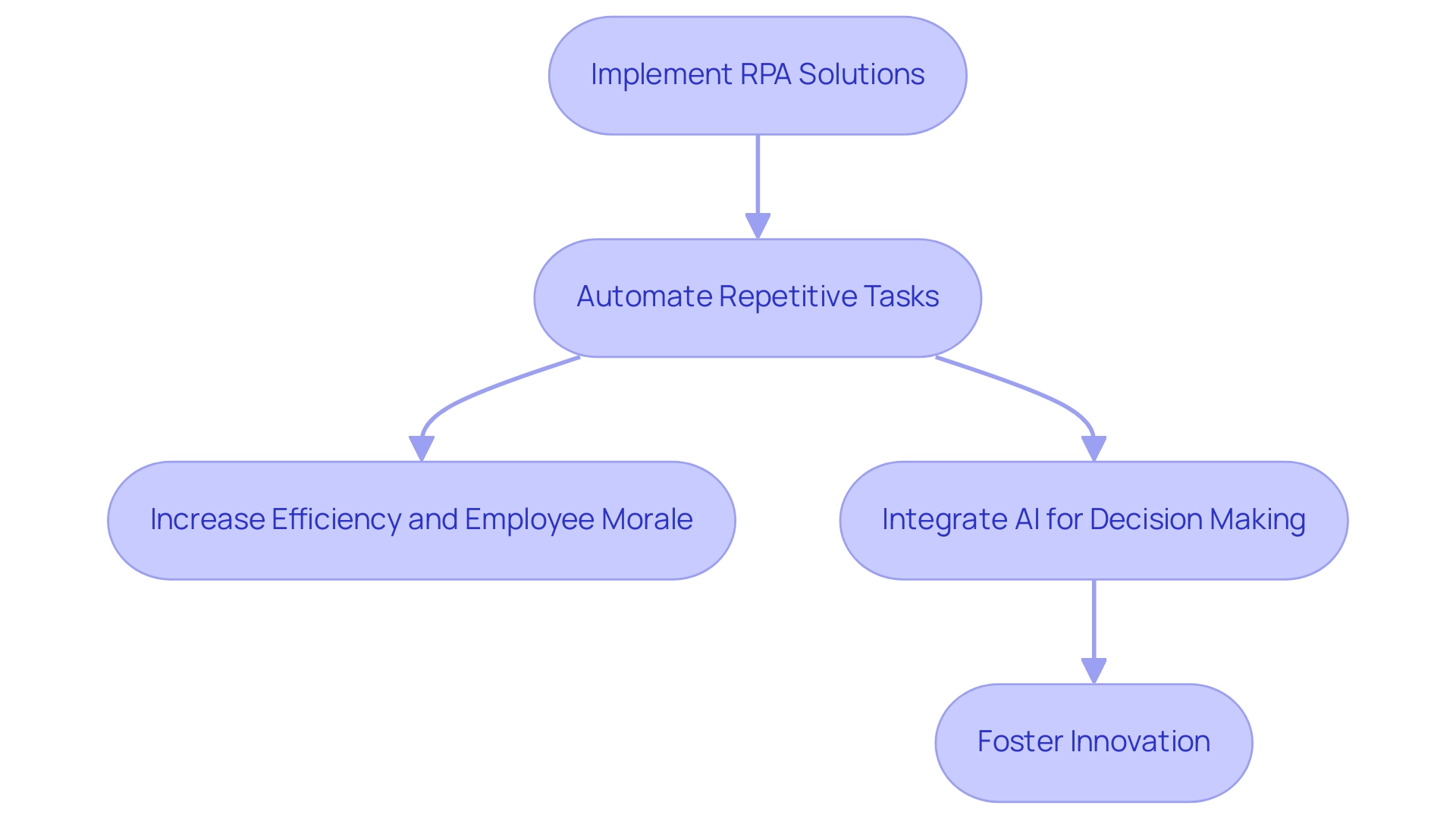
Data-Driven Insights: The Role of Business Intelligence in CoEs
Business intelligence (BI) is a cornerstone of the Center of Excellence (CoE) framework, compelling us to examine the objective of the CoE program in empowering organizations to make strategic decisions based on data-driven insights. By establishing robust BI practices, organizations can transform raw data into actionable information, enabling stakeholders to discern trends, assess performance, and evaluate the success of various initiatives. The implementation of advanced BI tools, such as Power BI, along with interactive dashboards, provides real-time visibility into critical metrics, fostering proactive decision-making.
In 2025, organizations that prioritize data-driven decision-making are projected to significantly outperform their competitors. A systematic literature review of 111 peer-reviewed studies from 2000 to 2019 reveals that best-in-class companies leverage data analytics and collaborative approaches to gain a competitive edge. This data-focused strategy not only enhances operational efficiency but also equips organizations to swiftly adapt to changing market dynamics and customer demands.
For instance, effective data analysis and reporting practices, including the 3-Day Power BI Sprint for rapid report creation, enable companies to visualize data trends and patterns, essential for driving business growth. Additionally, the General Management App facilitates comprehensive management and smart reviews, addressing data inconsistency and governance challenges in business reporting, thereby enhancing decision-making.
A notable case study on data analysis and reporting illustrates how SQL query optimization can significantly improve the performance of data analysis processes, leading to enhanced insights and decision-making capabilities. This optimization allows organizations to process data more efficiently, ultimately resulting in quicker and more precise decision-making.
Expert insights emphasize the objective of the CoE program in centers of excellence, highlighting the significance of BI. Data analytics professionals stress that converting raw data into valuable insights is crucial for informed decision-making. As noted by a trusted industry leader in remote DBA services, “With over 500 clients and a track record of delivering transaction speeds that are at least twice as fast as before, we guarantee a significant increase in performance.” By harnessing the power of BI, organizations can not only enhance performance but also cultivate a culture of continuous improvement and innovation.
Moreover, the utilization of generative AI technologies and Robotic Process Automation (RPA) can streamline workflows, enhance efficiency, and ultimately drive data-driven insights for business growth.

Unique Value Propositions of CoE Programs
Focusing on unique value propositions, Centers of Excellence (CoE) programs distinguish themselves from conventional models by emphasizing the objectives of the CoE program through their customized approach to solution personalization. A key advantage lies in their capacity to align solutions with specific business objectives, prompting inquiries into the goals of the CoE program. This alignment enhances data quality and streamlines AI implementation, driving substantial improvements in performance while cultivating a culture of innovation within organizations.
By promoting experimentation and the adoption of best practices, Centers of Excellence empower teams to adapt swiftly to market dynamics and harness emerging technologies, such as generative AI and Power BI.
Statistics reveal that 37% of customers prefer personalized suggestions based on their interests, underscoring the importance of customization in enhancing customer engagement and loyalty. Furthermore, case studies illustrate that brands implementing effective personalization strategies are more likely to retain customers, as understanding their needs is vital for fostering loyalty. As Esat Artug notes, “On getting personalization right, 56% of customers say they’ll remain loyal to brands who understand them.”
In this context, CoEs play a pivotal role in customizing solutions that not only meet functional goals but also resonate with customer expectations. This alignment ultimately drives performance and satisfaction, raising the question of what the objectives of the CoE program truly are.
Moreover, the transformative impact of Creatum GmbH’s Power BI Sprint is highlighted in client testimonials, showcasing how these solutions enhance business intelligence development and operational efficiency. The 3-Day Power BI Sprint enables entities to quickly produce professionally designed reports, ensuring efficient reporting and data consistency. Training and certification for advanced techniques in canvas apps and Power Platform development further enhance the capabilities of Centers of Excellence, equipping teams with the skills necessary to implement these customized solutions effectively.
By utilizing generative AI technologies and optimized workflow automation, Centers of Excellence can significantly enhance operational efficiency and productivity, preparing entities for sustained growth in an increasingly complex business landscape.
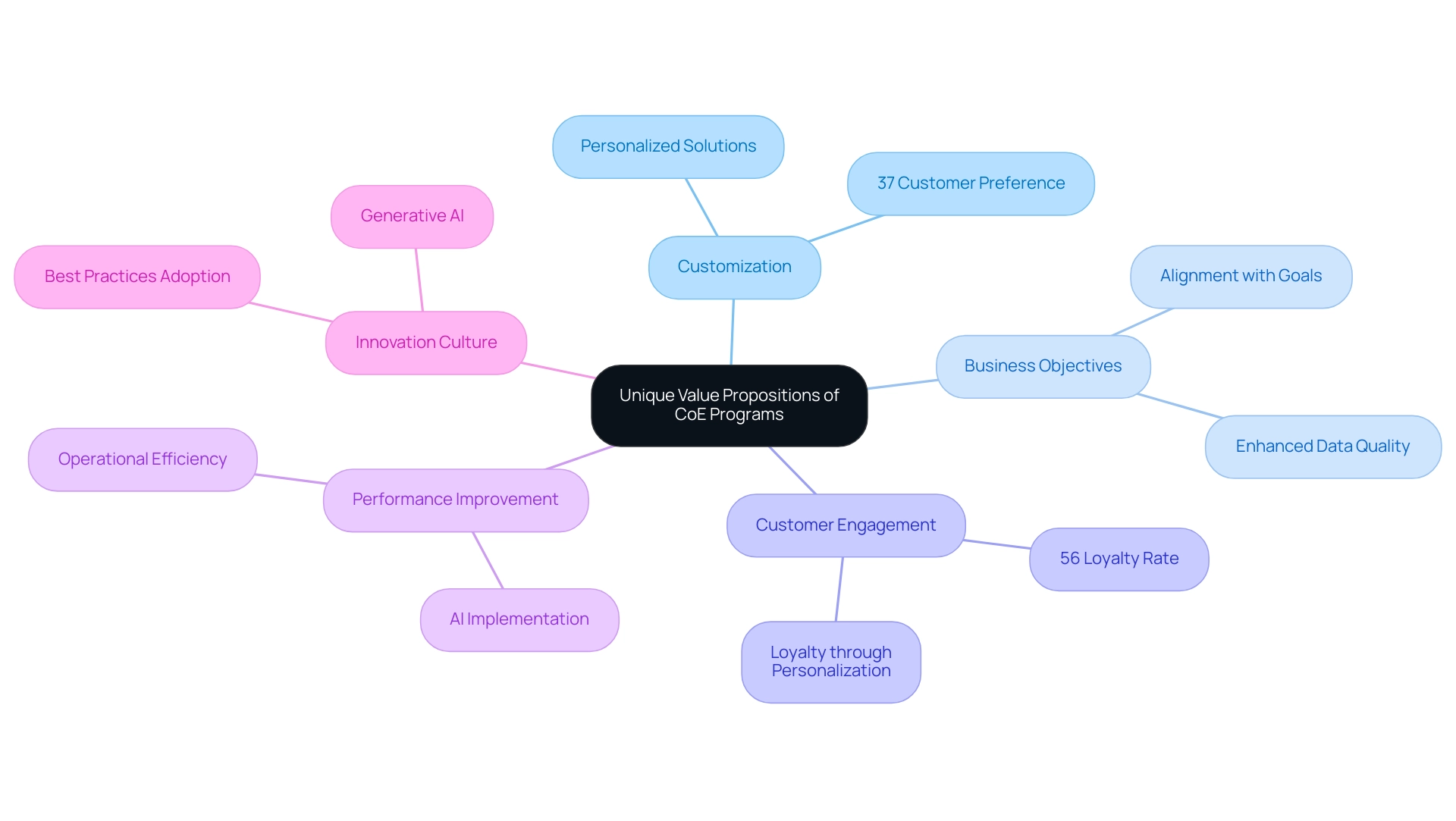
Impact of CoE Programs on Growth and Innovation
The influence of Centers of Excellence on organizational growth and innovation is substantial. By optimizing processes, enhancing collaboration, and harnessing advanced technologies like generative AI and Robotic Process Automation (RPA), centers of excellence enable entities to operate with greater efficiency and effectiveness. This quest for excellence in operations not only leads to enhanced customer experiences but also strengthens market competitiveness, paving the way for sustainable growth.
Moreover, Codes cultivate a culture of innovation, motivating teams to experiment with new ideas and technologies. This is essential for organizations to remain agile and responsive to evolving market conditions.
As highlighted in recent case studies, such as those involving machine monitoring and marketing, companies that effectively leverage generative AI technologies can achieve a competitive advantage. By understanding their core competencies and applying these insights to their business processes, they position themselves for success. For instance, the integration of Multi-Agent AI systems and graphical neural networks has revolutionized operations in these sectors, demonstrating the practical applications of these technologies.
Client testimonials further emphasize the impact of Creatum GmbH’s technology solutions, particularly in enhancing efficiency and driving business growth. Herr Malte-Nils Hunold from NSB GROUP noted, “Creatum’s solutions have transformed our operational processes, leading to significant efficiency gains.” The transformative effects of Creatum’s Power BI Sprint service have been noted in accelerating data analysis and reporting success, enabling informed decision-making that drives innovation.
Additionally, the importance of Business Intelligence and RPA in driving data-driven insights cannot be overstated. By automating manual workflows, companies can enhance productivity and focus on strategic initiatives that add value. Investing in CoE programs is therefore not merely a tactical choice; it is crucial to understand the objectives of the CoE program for achieving long-term success in today’s rapidly changing business landscape.
As organizations prioritize these initiatives, they position themselves to thrive in a competitive marketplace. High scores in customer satisfaction KPIs, such as Net Promoter Score (NPS), reflect the effectiveness of Codes in meeting stakeholder needs and enhancing overall customer experience.
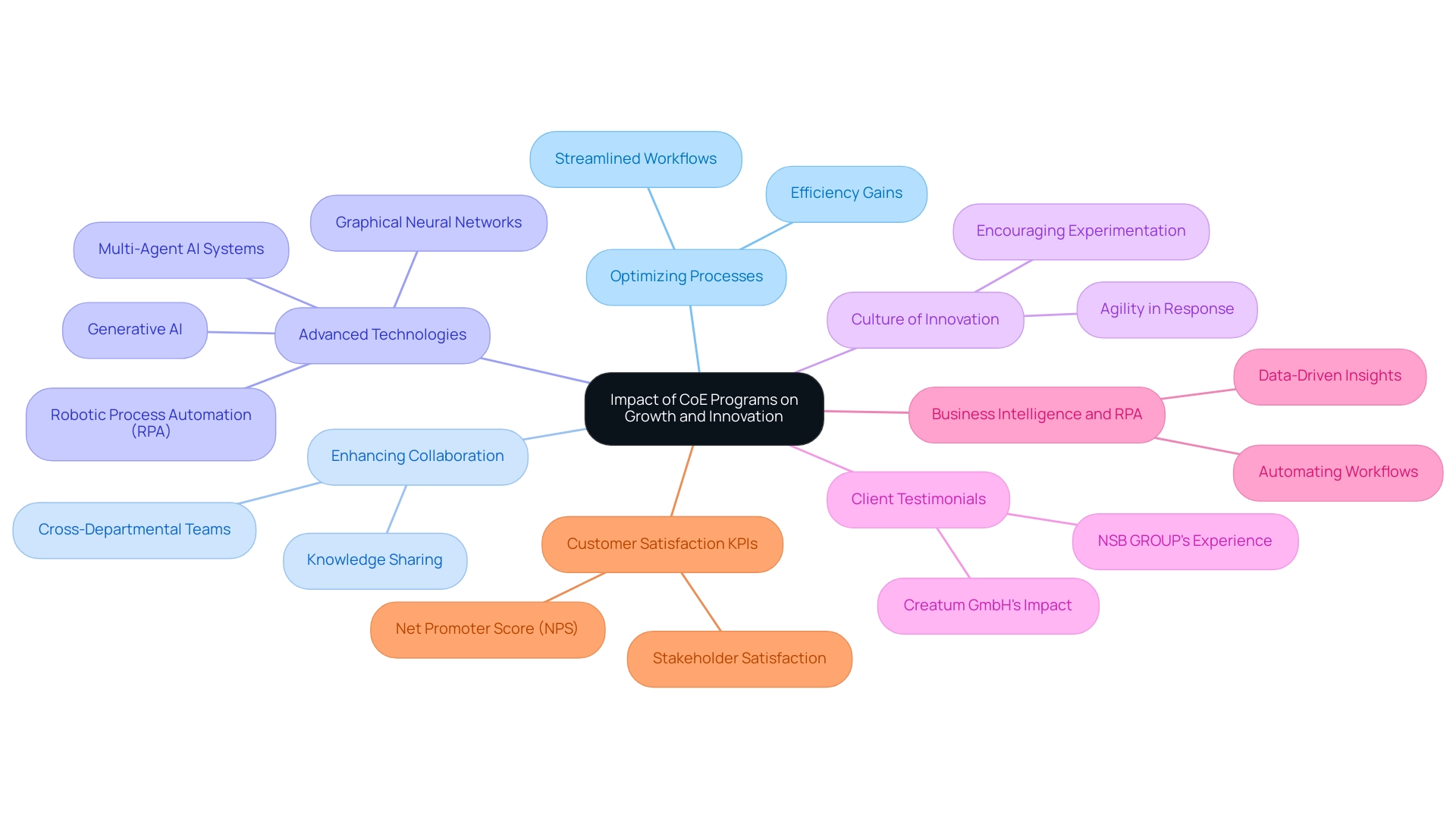
Conclusion
The transformative power of Centers of Excellence (CoEs) in today’s business landscape is undeniable. By centralizing expertise, fostering collaboration, and implementing advanced technologies such as Robotic Process Automation (RPA) and artificial intelligence (AI), CoEs enable organizations to drive operational efficiency and cultivate a culture of innovation. This strategic alignment not only enhances productivity but also positions organizations to swiftly adapt to changing market dynamics, ensuring sustainable growth.
Through the establishment of clear core objectives, CoEs effectively tackle operational challenges and streamline processes. They facilitate knowledge sharing, enhance data governance, and promote best practices—essential elements for organizations striving for continuous improvement. Successful case studies illustrate that organizations leveraging CoEs can significantly reduce inefficiencies and improve decision-making capabilities.
Moreover, by prioritizing effective change management and fostering a collaborative environment, CoEs empower teams to embrace new technologies and methodologies. This adaptability is crucial as businesses navigate uncertainties in an ever-evolving landscape. As organizations increasingly recognize the unique value propositions offered by CoE programs, they position themselves to outperform competitors and achieve deeper customer engagement.
Investing in CoEs transcends mere tactical decision-making; it is a strategic imperative that drives long-term success. As organizations harness the full potential of CoEs, they not only enhance operational capabilities but also pave the way for innovation and excellence in customer experiences. In conclusion, the role of CoEs in shaping the future of business is clear: they are essential for organizations aiming to thrive in a complex and competitive environment.
Frequently Asked Questions
What is a Center of Excellence (CoE)?
A Center of Excellence (CoE) is a dedicated team or entity within a company that focuses on a specific area of expertise, providing leadership, establishing best practices, conducting research, and offering support and training.
What is the main objective of the CoE program?
The main objective of the CoE program is to elevate performance and stimulate innovation by centralizing knowledge and resources, enabling organizations to leverage expertise effectively, resulting in enhanced processes, cost savings, and a culture of continuous improvement.
How do CoEs align strategic goals with functional capabilities?
CoEs play a vital role in aligning strategic goals with functional capabilities, enhancing efficiency and effectiveness across various functions within an organization.
What challenges do healthcare providers face when establishing CoEs?
Healthcare providers often face challenges in establishing CoEs, frequently resorting to a trial-and-error approach due to limited guidance, which can hinder the achievement of high-quality care.
Why is a comprehensive understanding of CoE operations important?
A comprehensive understanding of CoE operations is essential for organizations to replicate successful processes and achieve high-quality care, as highlighted by the experiences of organizations like the Willis-Knighton Health System.
What financial considerations are associated with establishing CoEs?
Establishing CoEs requires substantial financial resources, but this investment is justified by the excellence and improvements they foster within the organization.
How do CoEs enhance the depth and breadth of services in communities?
CoEs significantly enhance the depth and breadth of services available in communities by improving operational efficiency and streamlining workflows, ultimately transforming the quality of services provided.
What role do CoEs play in fostering innovation and collaboration?
CoEs serve as incubators for new ideas and technologies, facilitating knowledge sharing and collaboration among teams, which boosts efficiency and aligns strategic goals.
What impact do CoEs have on data governance?
Entities with a CoE are more likely to establish robust data governance frameworks, with studies showing that 80% of such entities have implemented effective governance strategies.
Can you provide an example of a successful CoE initiative?
Harvard University improved faculty and student engagement and enhanced administrative efficiency by integrating a comprehensive learning management system, showcasing the tangible benefits of CoE initiatives.
How do Robotic Process Automation (RPA) solutions contribute to CoE objectives?
RPA solutions like EMMA RPA and Microsoft Power Automate enhance productivity and employee morale by automating manual workflows, reducing errors, and improving overall efficiency.
What are some measurable outcomes of implementing CoEs?
A case study showed that GUI automation led to a 70% reduction in data entry errors and an 80% improvement in workflow efficiency, demonstrating the transformative impact of CoEs on business productivity.
